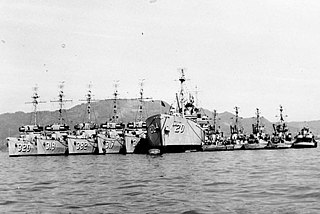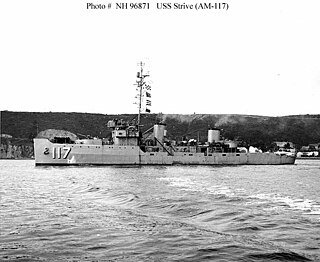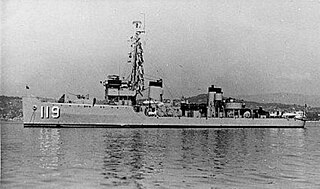
USS Surfbird (AM-383) was an Auk-class minesweeper built during World War II for the United States Navy. She was the only U.S. Navy ship named for the surfbird.

USS Thomas E. Fraser (DD-736/DM-24) was a Robert H. Smith-class destroyer minelayer in the United States Navy.

USS Serene (AM-300) was an Admirable-class minesweeper built for the United States Navy during World War II. She served in the Pacific Ocean and was awarded six battle stars. She was decommissioned and placed in reserve in 1946. In January 1964, the former Serene was transferred to South Vietnam as RVNS Nhật Tảo (HQ-10) in the Republic of Vietnam Navy. She was sunk in January 1974 during combat with Chinese forces in the Battle of the Paracel Islands.
USS Swift (AM-122) was an Auk-class minesweeper acquired by the United States Navy for the dangerous task of removing mines from minefields laid in the water to prevent ships from passing.

USS Shoveler (AM-382) was an Auk-class minesweeper acquired by the U.S. Navy for the dangerous task of removing mines from minefields laid in the water to prevent ships from passing.

USS Vigilance (AM-324) was an Auk-class minesweeper acquired by the United States Navy for the dangerous task of removing mines from minefields laid in the water to prevent ships from passing.

USS Staff (AM-114) was an Auk-class minesweeper acquired by the United States Navy for the dangerous task of removing mines from minefields laid in the water to prevent ships from passing.

USS Strive (AM-117) was an Auk-class minesweeper acquired by the United States Navy for the dangerous task of removing mines from minefields laid in the water to prevent ships from passing.

USS Steady (AM-118) was an Auk-class minesweeper acquired by the United States Navy for the dangerous task of removing mines from minefields laid in the water to prevent ships from passing.

USS Sustain (AM-119) was an Auk-class minesweeper acquired by the United States Navy for the dangerous task of removing mines from minefields laid in the water to prevent ships from passing.
USS Success (AM-310) was an Admirable-class minesweeper built for the United States Navy during World War II. She was awarded four battle stars for service in the Pacific during World War II. She was decommissioned in July 1946 and placed in reserve. While she remained in reserve, Success was reclassified as MSF-310 in February 1955 but never reactivated. In October 1962, she was sold to the Mexican Navy and renamed ARM DM-08. Although she is reported out of service, her ultimate fate is not reported in secondary sources.

USS Strength (AM-309) was a metal-hulled Admirable-class minesweeper built for the U.S. Navy during World War II. She received training in the United States before being sent directly to the Pacific Ocean to clear minefields so that Allied forces could proceed to beaches held by forces of the Empire of Japan. While performing this dangerous task, she was also attacked by Japanese planes and narrowly avoided being torpedoed. For her courageous actions in the war zone, she was awarded three battle stars.
USS Strategy (AM-308) was a steel-hulled Admirable-class minesweeper built for the U.S. Navy during World War II. She had a courageous and adventurous life in clearing minefields in areas controlled by Japanese forces. She survived attacks by Japanese gunfire and planes, and won four battle stars for her service under battle conditions.
USS Specter (AM-306) was an Admirable-class minesweeper built for the United States Navy during World War II. She was originally ordered, laid down, and launched as USS Spector (AM-306), but was renamed the correctly spelled Specter in March 1944. She was awarded four battle stars for service in the Pacific during World War II. She was decommissioned in 1946 and placed in reserve. While she remained in reserve, Specter was reclassified as MSF-306 in February 1955 but never reactivated. In April 1973, she was sold to the Mexican Navy and renamed ARM DM-04. In 1994 she was renamed ARM General Manuel E. Rincón (C52). She was stricken in July 2001, but her ultimate fate is not reported in secondary sources.
USS Device (AM-220) was an Admirable-class minesweeper built for the United States Navy during World War II. She was awarded three battle stars for service in the Pacific during World War II. She was decommissioned in August 1946 and placed in reserve. Although she did not see service in the war zone, Device was recommissioned in March 1950 during the Korean War and remained in commission until February 1954, when she was placed in reserve again. While she remained in reserve, Device was reclassified as MSF-220 in February 1955 but never reactivated. In October 1962, she was sold to the Mexican Navy and renamed ARM DM-11. In 1994 she was renamed ARM Cadete Agustín Melgar (C54), spelled Augustín Melgar in some sources. She was stricken in 2000, and scuttled for use as an artificial reef in Bahía de Loreto National Park.
USS Hilarity (AM-241) was an Admirable-class minesweeper built for the United States Navy during World War II. She was awarded two battle stars for service in the Pacific during World War II. She was decommissioned in 1946 and placed in the Atlantic Reserve Fleet. While she remained in reserve, Hilarity was reclassified as MSF-241 in February 1955 but never reactivated. In October 1962, she was sold to the Mexican Navy and renamed ARM DM-02. She was stricken in 1986 and scrapped in August 1988.
USS Rebel (AM-284) was an Admirable-class minesweeper built for the United States Navy during World War II. She was awarded four battle stars for service in the Pacific during World War II. She was decommissioned in June 1946 and placed in reserve. While she remained in reserve, Rebel was reclassified as MSF-284 in February 1955 but never reactivated. In October 1962, she was sold to the Mexican Navy and renamed ARM DM-14. In 1994 she was renamed ARM Cadete Fernando Montes de Oca (C57). She was stricken in July 2001, but her ultimate fate is not reported in secondary sources.
USS Recruit (AM-285) was an Admirable-class minesweeper built for the United States Navy during World War II. She was awarded 3 battle stars for service in the Pacific during World War II. She was decommissioned in August 1946 and placed in reserve. While she remained in reserve, Recruit was reclassified as MSF-285 in February 1955 but never reactivated. In 1963, she was sold to the Mexican Navy and renamed ARM DM-07. Although she is reported out of service, her ultimate fate is not reported in secondary sources.
USS Signet (AM-302) was an Admirable-class minesweeper built for the United States Navy during World War II. She received four battle stars during World War II. She was decommissioned in December 1945 and placed in reserve. In February 1955, while still in reserve, her hull number was changed from AM-302 to MSF-302, but she was not reactivated. She was transferred to the Dominican Republic in January 1965 and renamed Tortuguero (BM455). She was employed as a patrol vessel in Dominican Navy service. Her pennant number was changed from BM455 to C455 in 1995. Tortuguero was stricken and hulked in 1997.
USS Skirmish (AM-303) was an Admirable-class minesweeper built for the United States Navy during World War II. She received four battle stars during World War II. She was decommissioned in December 1945 and placed in reserve. In February 1955, while still in reserve, her hull number was changed from AM-303 to MSF-303, but she was not reactivated. She was transferred to the Dominican Republic in January 1965 and renamed Separación (BM455). She was employed as a patrol vessel in Dominican Navy service and renamed Prestol Botello in 1976. Her pennant number was changed from BM454 to C454 during a 1995 refit. As of 2007, Prestol Botello remained in active service for the Dominican Navy.









